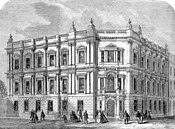Thames Embankment
This article needs additional citations for verification. (February 2016) |

The Thames Embankment is a work of 19th-century civil engineering that reclaimed marshy land next to the River Thames in central London. It consists of the Victoria Embankment and Chelsea Embankment.
History
There had been a long history of failed proposals to embank the Thames in central London. Embankments along the Thames were first proposed by Christopher Wren in the 1660s, then in 1824 former soldier and aide to George IV, Sir Frederick Trench suggested an embankment[1] known as 'Trench's Terrace' from Blackfriars to Charing Cross. Trench brought a bill to Parliament which was blocked by river interests. In the 1830s, the painter John Martin promoted an embankment to contain an intercepting sewer. In January 1842 the City Corporation adopted a plan designed by James Walker but the plan fell foul of government infighting. The government itself built the Chelsea Embankment in 1854 from Chelsea Hospital to Millbank.

Started in 1862, the present embankment on the northern side of the river was primarily designed by Sir Joseph Bazalgette. It incorporates the main low level interceptor sewer from west London, and an underground railway over which a wide road and riverside walkway were also constructed, as well as a retaining wall along the north side of the River Thames. In total, Bazalgette's scheme reclaimed 22 acres (89,000 m2) of land from the river. It prevented flooding; but it cut many waterfront houses and buildings off from boat access via their watergates.
Much of the granite used in the projects was brought from Lamorna Cove in Cornwall. The quarried stone was shaped into blocks on site before being loaded on to barges and transported up the English Channel into the Thames.
From Battersea Bridge in the west, the Thames Embankment includes sections of Cheyne Walk, Chelsea Embankment, Grosvenor Road, Millbank and Victoria Tower Gardens. Beyond the Houses of Parliament, it is named Victoria Embankment as it stretches to Blackfriars Bridge; this stretch also incorporates a section of the London Underground network used by the District and Circle Lines, and also passes Shell Mex House and the Savoy Hotel. The embankment also incorporates several stretches of gardens and open space, collectively known as the Embankment Gardens, which provide a peaceful oasis within the heart of Central London. The gardens include many statues, including a memorial with a bust of Bazalgette.
The much smaller Albert Embankment is on the south side of the river, opposite the Millbank section of the Thames Embankment. It was created by Bazalgette for the Metropolitan Board of Works and built by William Webster between July 1866 and November 1869.
Some parts of the Embankment were built in the twentieth century, having been reconstructed following wartime bomb damage or natural disasters such as the 1928 Thames flood.
See also
References
- ^ Sholto Percy (1841). Mechanics' Magazine and Journal of Science, Arts, and Manufactures. Knight and Lacey. p. 242.
External links
- Trench, Frederick William (1841). Letter from Sir Frederick Trench to the Viscount Duncannon on his proposal for a quay on the north bank of the Thames.
- Streets in the City of Westminster
- Streets in the Royal Borough of Kensington and Chelsea
- Buildings and structures in the City of Westminster
- Buildings and structures in the Royal Borough of Kensington and Chelsea
- London water infrastructure
- Infrastructure in London
- Waterfronts
- Buildings and structures on the River Thames

